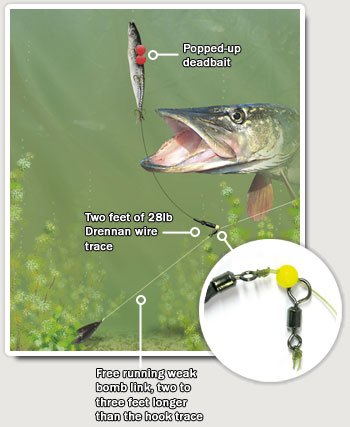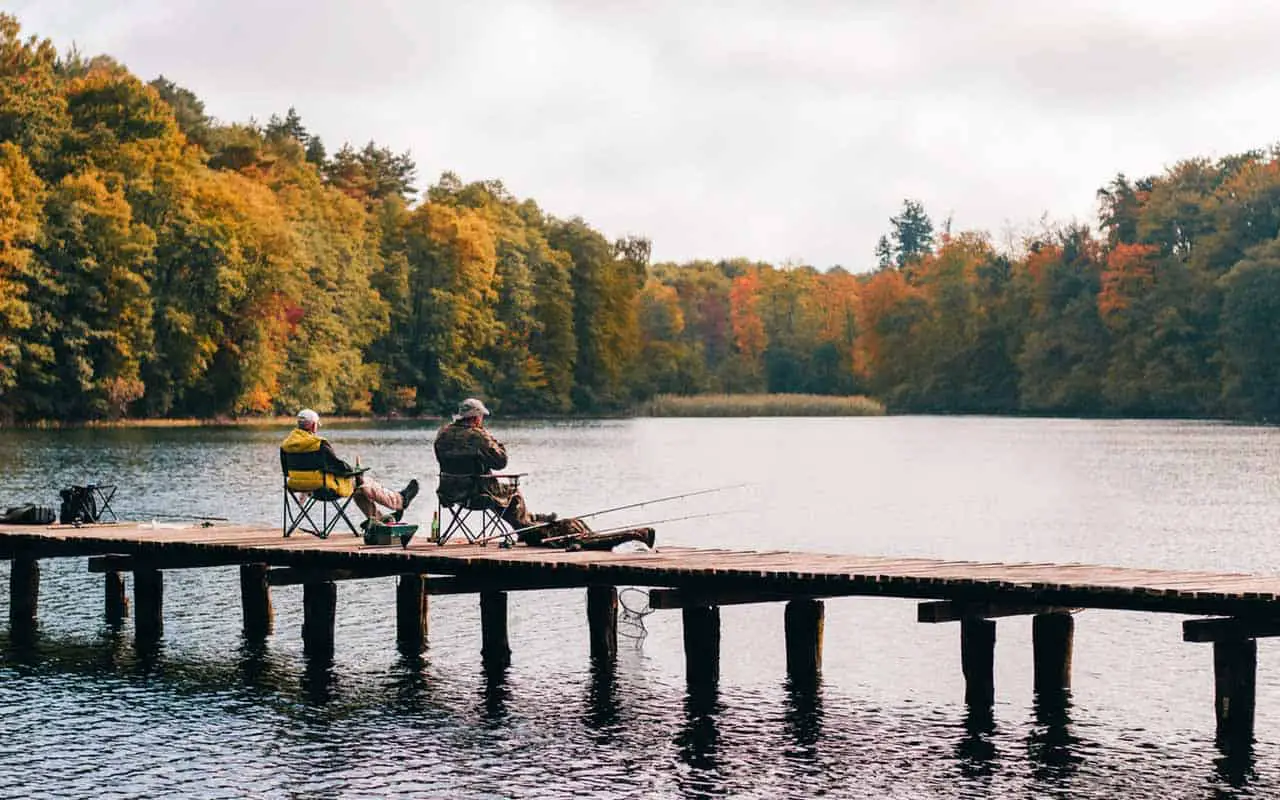Dead bait pike fishing is one of many great ways to catch pike both in rivers and lakes. There are a few elements, however, that make this tactic so amazingly effective when used right.
For a beginner, dead bait fishing might seem like a lot of hassle to even get started with. You need to get bait, carry a lot of stuff with you, set up rigs, set the hook the right way, etc. The truth is, once it’s all set up – bait fishing is amazing.
Once you get the hang of it you can set up multiple rigs, lay back and enjoy the show. And the time spent on preparing is well worth it – trust me!
Dead bait pike fishing is definitely one of the most lucrative ways of catching many and also big Northern pike. It’s a skill that you should learn and have.
Why is Dead bait fishing so effective?
Most people, when starting out pike fishing, usually go with a simple rod-reel-lure setup and stick with it most of the time.
This is not to say that there’s anything wrong with this approach. Lure fishing is a very fun, active, and quite
Also, there’s an infinite number of different lures to try. Buying lures
But at its core, dead bait fishing is just a much more effective approach to pike fishing.
3 Major Reasons Why Dead Bait Pike Fishing Is So Effective:
- The scent of dead bait
- The time factor
- Multitasking
The Scent Of Dead Bait
One of the main reasons why dead baits are so effective is because they emit certain scent in the water. And as you may guess, pike are drawn to the scent of bait better than to artificial lures.
We’ll discuss the best bait for Northern pike later in the article but in general – baits with stronger scent can attract pike from a longer distance.
Using scent as a beacon is especially effective in peak fishing hours just after sunrise and before sunset. At those times, pike are very active and searching for prey.
The Time Factor
Tied together with the scent factor is the time factor of dead bait fishing.
Although lure fishing makes it possible to cover a lot of ground in a short period of time, the fraction of time your lure is actually in the water is a lot smaller than with dead bait.
Therefore, if the pike isn’t as active, you might miss out on a monster pike because they like to conserve energy.
Because the bait is in the water for a much longer time and staying in one spot – pike have more time to pick up on the scent respond to it with an attack.
Take a look at the following video of how long pike may think before actually taking the bait.
Multitasking
The third major reason why dead bait pike fishing can be much more volatile approach is multitasking. You are able to set multiple baits into the water at once.
Think of it like this: If you’re lure fishing, you’re always handling one rod and one lure at a time. It’s a very active fishing method but it’s not scalable.
You could say that bait fishing is much more passive in that sense. You set your rig up and wait until you get a hit. In the meanwhile you’re able to set up another rig, or more.
And having 2-3 rigs at once in water will keep you busy most of the time and thus give you a very interesting fishing experience.
What is the best dead bait for pike fishing?
When choosing Northern pike bait you might start thinking about their diet and what would work best on them. If you want to learn more about the Northern pike diet I have written a separate article about it.
Different from some other species, pike isn’t very picky about what it eats – as long as it’s them who gets to eat it. The only thing you should be considering is the scent of the dead bait.
As pike is a voracious predator you can get away with using different dead bait. Just keep the bait as fresh as possible for it to work the best.
Here are some great examples of what baits you can use for pike fishing:
- Shiners
- Roaches
- Mackerel
- Perch
- Sprat
- Sardine
- Herring
Keeping Dead Bait Fresh Overnight
If you plan to go fishing early in the morning it’s a good idea to get the dead bait ready a day before. This way you don’t have to waste precious time in the morning when you could instead be catching pike already.
As mentioned earlier, with Northern pike bait it’s not as much about what fish you’re using as long as it is fresh. Don’t keep the bait in warm temperature overnight as it starts to rotten and might not be attracting pike as well.
To keep it cool and fresh it’s a good idea to put it in the freezer overnight. To do that, use a ziplock bag to keep all the oils and smell in.
Try to keep them cool until you’re at the location and want to start using them. Let the bait soften up a bit before hooking it on to make it easier. Once the bait is in the water it will unfreeze completely and start emitting its scent.
How to hook dead bait to your rig?
So, now that you’re by the water and want to start fishing you need to hook the dead bait onto your rig. But how?
There are actually a number of ways you can hook the bait and it somewhat depends on which dead bait rig you’re using. Whether you’re using a one or two treble hook setup.
If you’re using a one hook setup, you have two option: either you set the hook through its head or before the back fin. Setting the hook before the back fin keeps the bait nice and level giving the setup a pleasing presentation.
If, however, you’ve gone with the double treble hook setup you’ll want to set the hooks either running from the side or the back.
Either way, keep in mind that the ends of the hooks should be facing towards the tail of the bait. As northern pike usually swallow fish head first, it will be hooked once you start pulling and reeling it in.
Dead Bait Rigs For Lakes And Rivers
Setting up rigs for your dead bait setup is probably the most trickiest part as it takes some knowledge and getting used to. It’s important to understand where you’re about to fish and what the conditions are like.
Do you need a float or is it
The Quick Strike Rig
This is probably the easiest rig you can have. The whole idea around this is to get the bait in the water as quickly as possible.
For that, you need one treble or single head hook, a leader, and a weight. You can adjust the hook accordingly to your own preference either through the upper lip or through the back near the back fin.
Use a weight heavy enough to keep the bait near the bottom but light enough that pike won’t notice it.
The weigh should run on a separate line tied from the main line and about 12 in (30 cm) from the hookset.
This rig works especially well when ice fishing for pike, but can also be used during other seasons either in rivers or lakes.
The Float Rig

The
For this rig, you also need a float that will help you see when pike are attacking your bait.
The difference with the float rig and a quick strike rig is that the weight bomb runs on the main line and bait runs on a loose swivel attached to the main line. That allows for a resistance-free grab for pike, thus causing no alarm in them.
Pre-Tied Rigs
If you don’t want to tie your own dead bait rigs, there’s always the possibility to buy pre-tied rigs.
The only thing with pre-tied rigs is that may not have the perfect amount line for the weights or hooks – this is something you need to watch out for. Usually it’s possible to modify the pre-tied rigs a bit to be more suitable for you.
TIP: For better results in making your own rigs, you might want to consult with someone at a fishing store. They usually have good knowledge about different rigs and how to best set them up.
Hook Size For Dead Baits
One question which people seem to have about dead bait rigs is how big should the hooks be for dead baits. And if you ask different people you’ll get different answers.
Some like smaller, some bigger hooks – some like single, some treble hooks. As I tend to use the ledger rig the most, I use treble hooks.
For the size, I have found that size 4 or 6 do the trick best. They’re large enough to hook pike and won’t hurt them as much as larger hooksets.
Rod And Reel For Dead Bait Pike Fishing
When you want to start fishing pike with dead bait, it’s a good idea to also take a look at the gear you plan on using.
There are some differences when compared to lure fishing, that make dead bait fishing easier. One of which being the length of the rod.
When lure fishing for pike, you usually have a rod that is around 7-8 ft (2,1-2,4 m) long. As you dead bait rig is bigger in size and ofter also heavier, it’s much easier to cast with a longer rod – e.g. 9-10 ft (2,7-3 m). That extra length gives you much greater force and lets you cast the rig more easily.
As for the reel – you can use the same reel for dead bait as you use for lure fishing. For pike fishing, it’s always a good idea to use a larger reel (4000 and up) so that you can use thicker line for extra strength.
For the main line, I mostly recommend a 25+ lb braided line but if the water bottom is very rocky you can use strong fluoro or mono instead as they don’t tare as easily.
Dead Bait Pike Ice Fishing
If ice fishing is something you want to get into, dead bait is definitely the way to go. As mentioned earlier, dead baits attract pike with their scent so even if you’re not in the perfect spot, pike will find you more easily.
You can use simple rigs with one hook set through the upper lip or before the back fin.
If you want to use a bigger bait and more stable rig, you can have a swivel at the top of the main line, from which two leaders come off and have treble hooks at the top of the leaders. This way you’re able to set one treble through the head and the other through the back.
Best Bait For Pike Ice Fishing
Usually, the same rules apply in every season – the greasier the fish is the more scent it lets out.
If possible, you can try herring as dead bait. Herring is a perfect bait because it’s very oily and produces a lot of scent which pike can start hunting down quickly.
In case herring is not an option, all the other fish mentioned earlier – like roaches, mackerel, sardine, sprat, perch – work just fine.
I really hope that this article helped you answer questions about dead bait pike fishing. If you liked the article, please be sure to share it with friends who might also be seeking that information.
Cheers
